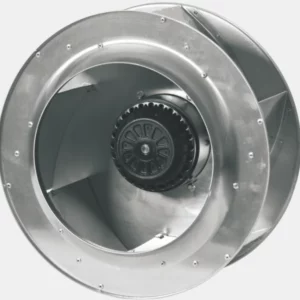When comparing backward inclined centrifugal fans and backward curved centrifugal fans.
Here are a few key differences to consider:
- Blade Design: The primary difference between the two fan types lies in their blade design. Backward inclined centrifugal fans have blades that are inclined at an angle to the direction of rotation, resembling a backward-sloping ramp. On the other hand, backward curved centrifugal fans have blades that curve backward, opposite to the direction of rotation.
- Performance Characteristics: Backward inclined centrifugal fans are known for their high-efficiency performance, particularly in applications with lower system resistances. They are capable of generating higher static pressures and are often used in HVAC systems where the fan needs to overcome resistance from ductwork and filters. Backward curved centrifugal fans, on the other hand, are designed to handle higher airflow volumes with lower static pressures. They are typically utilized in applications where there is less resistance to airflow, such as cleanrooms or air purifiers.
- Noise Levels: In terms of noise levels, backward inclined centrifugal fans tend to operate at lower noise levels compared to backward curved centrifugal fans. The inclined blade design of backward inclined fans helps reduce turbulence and noise generation, making them suitable for applications that require quieter operation.
- Efficiency: Backward inclined centrifugal fans generally exhibit higher efficiency compared to backward curved centrifugal fans. The inclined blade design allows for better aerodynamic performance, resulting in improved fan efficiency and lower energy consumption.
- Size and Space Requirements: Backward inclined centrifugal fans are typically larger in size compared to backward curved centrifugal fans for the same airflow and pressure requirements. This can impact the space requirements for installation. Backward curved centrifugal fans are often more compact and may be better suited for applications where space is limited.
- Application Suitability: Backward inclined centrifugal fans are well-suited for applications that require high static pressure capabilities, such as HVAC systems, industrial ventilation, and dust collection systems. They are effective in overcoming resistance and maintaining airflow in systems with higher ductwork or filter resistance. Backward curved centrifugal fans are more suitable for applications that require high airflow volumes with lower static pressures, such as air purifiers, cleanrooms, or cooling applications.
It’s important to note that specific fan models and designs can vary, and manufacturers may offer variations within the backward inclined and backward curved fan categories. The selection of the appropriate fan type depends on the specific requirements of the application, including airflow, backward inclined centrifugal fan static pressure, noise considerations, efficiency goals, and available installation space.
When it comes to backward-inclined centrifugal fans and backward-curved centrifugal fans.
Here are some other aspects to consider:
Fan characteristics: Backward-inclined centrifugal fans are excellent in terms of high efficiency performance, especially for applications with low system resistance. They produce high static pressure and are commonly used in HVAC systems where air duct and filter resistance needs to be overcome. The backward-bending centrifugal fan is more suitable for handling high air volume at lower static pressure. They are often used in applications with low resistance, such as clean rooms or air purifiers.
- Noise level: In terms of noise level, backward-inclined centrifugal fans usually produce less noise than backward-curved centrifugal fans when operating. The backward-inclined fan design reduces turbulence and noise generation for applications that require quieter operation.
- Efficiency: Compared to back-bending centrifugal fans, back-tilting centrifugal fans usually show higher efficiency. The inclined blade design contributes to better aerodynamic performance, increased fan efficiency and reduced energy consumption.
- Size and space requirements: Under the same air volume and pressure requirements, the backward-inclined centrifugal fan is usually larger than the backward-curved centrifugal fan. This may affect the space required for installation. Backward-curved centrifugal fans are generally more compact and more suitable for applications where space is limited.
- Application Suitability: Backward-inclined centrifugal fans are ideal for applications requiring high static pressure, such as HVAC systems, industrial ventilation and dust collection systems. They are effective at overcoming resistance and maintaining airflow in the system. Backward-curved centrifugal fans are more suitable for applications requiring high air volumes and lower static pressure, such as air purifiers, clean rooms or cooling applications.
It is important to note that specific fan models and designs may vary, and manufacturers may offer different variants in the backward-inclined and backward-bent fan categories. Choosing the right fan type depends on the specific requirements of the application, including air volume, static pressure, noise considerations, efficiency goals, and available installation space.
If you have specific questions or need more detailed information, please provide more specific context and I will be happy to assist you further.

